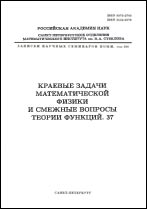|
|
Zapiski Nauchnykh Seminarov POMI, 2001, Volume 276, Pages 312–333
(Mi znsl1424)
|
 |
|
 |
This article is cited in 1 scientific paper (total in 1 paper)
Class numbers of indefinite binary quadratic forms
O. M. Fomenko
St. Petersburg Department of V. A. Steklov Institute of Mathematics, Russian Academy of Sciences
Abstract:
Let $h(d)$ be the class number of properly equivalent primitive binary quadratic forms $ax^2+bxy+cy^2$ of discriminant $d=b^2-4ac$. The case of indefinite forms $(d<0)$ is considered.
Assuming that the extended Riemann hypothesis for some fields of algebraic numbers holds, the following results are proved.
1. Let $\alpha(x)$ be an arbitrarily slow monotonically increasing function such that $\alpha(x)\to\infty$. Then
$$
\#\biggl\{p\le x\bigg\vert\biggl(\frac5p\biggr)=1,\,h(5p^2)>(\log p)^{\alpha(p)}\biggr\}=o(\pi(x)),
$$
where $\pi(x)=\#\{p\le x\}$.
2. Let $F$ be an arbitrary sufficiently large positive constant. Then for $x>x_F$ , the relation
$$
\#\biggl\{p\le x\bigg\vert\biggl(\frac 5p\biggr)=1,\,h(5p^2)>F\biggr\}\asymp\frac{\pi(x)}F
$$
holds.
3. The relation
$$
\#\biggl\{p\le x\bigg\vert\biggl(\frac5p\biggr)=1,\,h(5p^2)=2\biggr\}\sim\frac9{19}A\pi(x)
$$
holds, where $A$ is Artin's constant.
Hence, for the majority of discriminants of the form $d=5p^2$, where $\bigl(\frac 5p\bigr)=1$, the class numbers are small. This is consistent with the Gauss conjecture concerning the behavior of $h(d)$ for the majority of discriminants $d>0$ in the general case.
Received: 26.03.2001
Citation:
O. M. Fomenko, “Class numbers of indefinite binary quadratic forms”, Analytical theory of numbers and theory of functions. Part 17, Zap. Nauchn. Sem. POMI, 276, POMI, St. Petersburg, 2001, 312–333; J. Math. Sci. (N. Y.), 118:1 (2003), 4918–4932
Linking options:
https://www.mathnet.ru/eng/znsl1424 https://www.mathnet.ru/eng/znsl/v276/p312
|

| Statistics & downloads: |
| Abstract page: | 320 | | Full-text PDF : | 70 |
|




 Contact us:
Contact us: Terms of Use
Terms of Use
 Registration to the website
Registration to the website Logotypes
Logotypes








 Citation in format
Citation in format 
